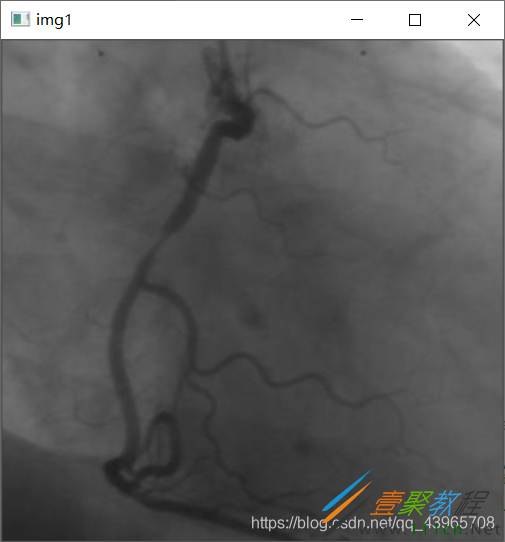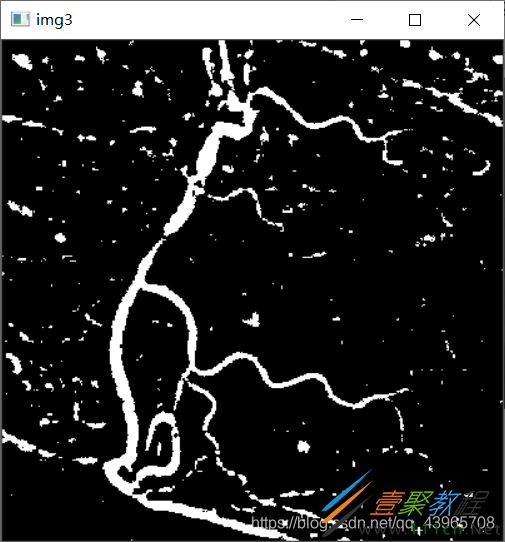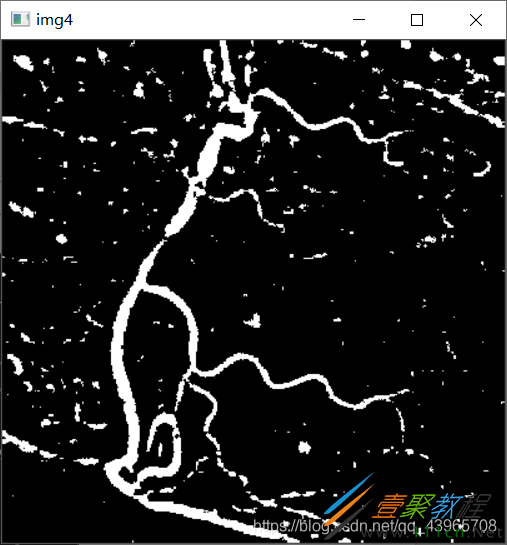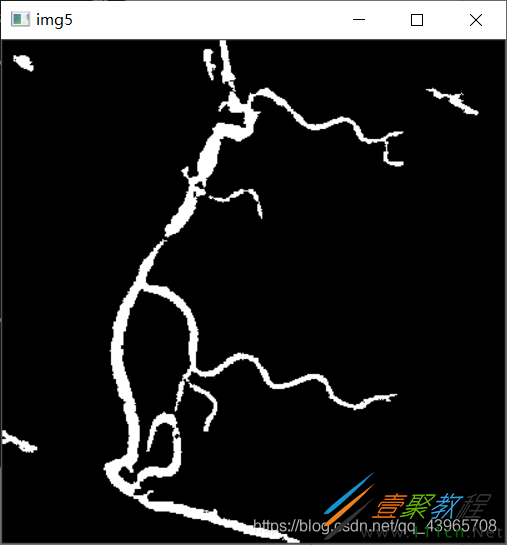最新下载
热门教程
- 1
- 2
- 3
- 4
- 5
- 6
- 7
- 8
- 9
- 10
Python opencv医学处理实现代码示例
时间:2021-05-11 编辑:袖梨 来源:一聚教程网
本篇文章小编给大家分享一下Python opencv医学处理实现代码示例,文章代码介绍的很详细,小编觉得挺不错的,现在分享给大家供大家参考,有需要的小伙伴们可以来看看。
题目描述
利用opencv或其他工具编写程序实现医学处理。
实现过程
# -*- coding: utf-8 -*-
'''
作者 : 丁毅
开发时间 : 2021/5/9 16:30
'''
import cv2
import numpy as np
# 图像细化
def VThin(image, array):
rows, cols = image.shape
NEXT = 1
for i in range(rows):
for j in range(cols):
if NEXT == 0:
NEXT = 1
else:
M = int(image[i, j - 1]) + int(image[i, j]) + int(image[i, j + 1]) if 0 < j < cols - 1 else 1
if image[i, j] == 0 and M != 0:
a = [0]*9
for k in range(3):
for l in range(3):
if -1 < (i - 1 + k) < rows and -1 < (j - 1 + l) < cols and image[i - 1 + k, j - 1 + l] == 255:
a[k * 3 + l] = 1
sum = a[0] * 1 + a[1] * 2 + a[2] * 4 + a[3] * 8 + a[5] * 16 + a[6] * 32 + a[7] * 64 + a[8] * 128
image[i, j] = array[sum]*255
if array[sum] == 1:
NEXT = 0
return image
def HThin(image, array):
rows, cols = image.shape
NEXT = 1
for j in range(cols):
for i in range(rows):
if NEXT == 0:
NEXT = 1
else:
M = int(image[i-1, j]) + int(image[i, j]) + int(image[i+1, j]) if 0 < i < rows-1 else 1
if image[i, j] == 0 and M != 0:
a = [0]*9
for k in range(3):
for l in range(3):
if -1 < (i-1+k) < rows and -1 < (j-1+l) < cols and image[i-1+k, j-1+l] == 255:
a[k*3+l] = 1
sum = a[0]*1+a[1]*2+a[2]*4+a[3]*8+a[5]*16+a[6]*32+a[7]*64+a[8]*128
image[i, j] = array[sum]*255
if array[sum] == 1:
NEXT = 0
return image
array = [0, 0, 1, 1, 0, 0, 1, 1, 1, 1, 0, 1, 1, 1, 0, 1,
1, 1, 0, 0, 1, 1, 1, 1, 0, 0, 0, 0, 0, 0, 0, 1,
0, 0, 1, 1, 0, 0, 1, 1, 1, 1, 0, 1, 1, 1, 0, 1,
1, 1, 0, 0, 1, 1, 1, 1, 0, 0, 0, 0, 0, 0, 0, 1,
1, 1, 0, 0, 1, 1, 0, 0, 0, 0, 0, 0, 0, 0, 0, 0,
0, 0, 0, 0, 0, 0, 0, 0, 0, 0, 0, 0, 0, 0, 0, 0,
1, 1, 0, 0, 1, 1, 0, 0, 1, 1, 0, 1, 1, 1, 0, 1,
0, 0, 0, 0, 0, 0, 0, 0, 0, 0, 0, 0, 0, 0, 0, 0,
0, 0, 1, 1, 0, 0, 1, 1, 1, 1, 0, 1, 1, 1, 0, 1,
1, 1, 0, 0, 1, 1, 1, 1, 0, 0, 0, 0, 0, 0, 0, 1,
0, 0, 1, 1, 0, 0, 1, 1, 1, 1, 0, 1, 1, 1, 0, 1,
1, 1, 0, 0, 1, 1, 1, 1, 0, 0, 0, 0, 0, 0, 0, 0,
1, 1, 0, 0, 1, 1, 0, 0, 0, 0, 0, 0, 0, 0, 0, 0,
1, 1, 0, 0, 1, 1, 1, 1, 0, 0, 0, 0, 0, 0, 0, 0,
1, 1, 0, 0, 1, 1, 0, 0, 1, 1, 0, 1, 1, 1, 0, 0,
1, 1, 0, 0, 1, 1, 1, 0, 1, 1, 0, 0, 1, 0, 0, 0]
# 显示灰度图
img = cv2.imread(r"C:UserspcDesktopvas0.png",0)
cv2.imshow("img1",img)
# 自适应阈值分割
img2 = cv2.adaptiveThreshold(img, 255, cv2.ADAPTIVE_THRESH_MEAN_C, cv2.THRESH_BINARY, 17, 4)
cv2.imshow('img2', img2)
# 图像反色
img3 = cv2.bitwise_not(img2)
cv2.imshow("img3", img3)
# 图像扩展
img4 = cv2.copyMakeBorder(img3, 1, 1, 1, 1, cv2.BORDER_REFLECT)
cv2.imshow("img4", img4)
contours, hierarchy = cv2.findContours(img4, cv2.RETR_EXTERNAL, cv2.CHAIN_APPROX_NONE)
# 消除小面积
img5 = img4
for i in range(len(contours)):
area = cv2.contourArea(contours[i])
if (area < 80) | (area > 10000):
cv2.drawContours(img5, [contours[i]], 0, 0, -1)
cv2.imshow("img5", img5)
num_labels, labels, stats, centroids = cv2.connectedComponentsWithStats(img5, connectivity=8, ltype=None)
# print(stats)
s = sum(stats)
img6 = np.ones(img5.shape, np.uint8) * 0
for (i, label) in enumerate(np.unique(labels)):
# 如果是背景,忽略
if label == 0:
# print("[INFO] label: 0 (background)")
continue
numPixels = stats[i][-1]
div = (stats[i][4]) / s[4]
# print(div)
# 判断区域是否满足面积要求
if round(div, 3) > 0.002:
color = 255
img6[labels == label] = color
cv2.imshow("img6", img6)
# 图像反色
img7 = cv2.bitwise_not(img6)
# 图像细化
for i in range(10):
VThin(img7, array)
HThin(img7, array)
cv2.imshow("img7",img7)
# 边缘检测
img8 = cv2.Canny(img6, 80, 255)
cv2.imshow("img8", img8)
# 使灰度图黑白颠倒
img9 = cv2.bitwise_not(img8)
cv2.imshow("img9", img9)
cv2.waitKey(0)
运行结果
-
上一个: 用Python下载抖音无水印视频代码示例
相关文章
- Golang ProtoBuf的基本语法详解 10-20
- Python识别MySQL中的冗余索引解析 10-20
- Python+Pygame绘制小球代码展示 10-18
- Python中的数据精度问题介绍 10-18
- Python随机值生成的常用方法介绍 10-18
- python3解压缩.gz文件分析 09-27























